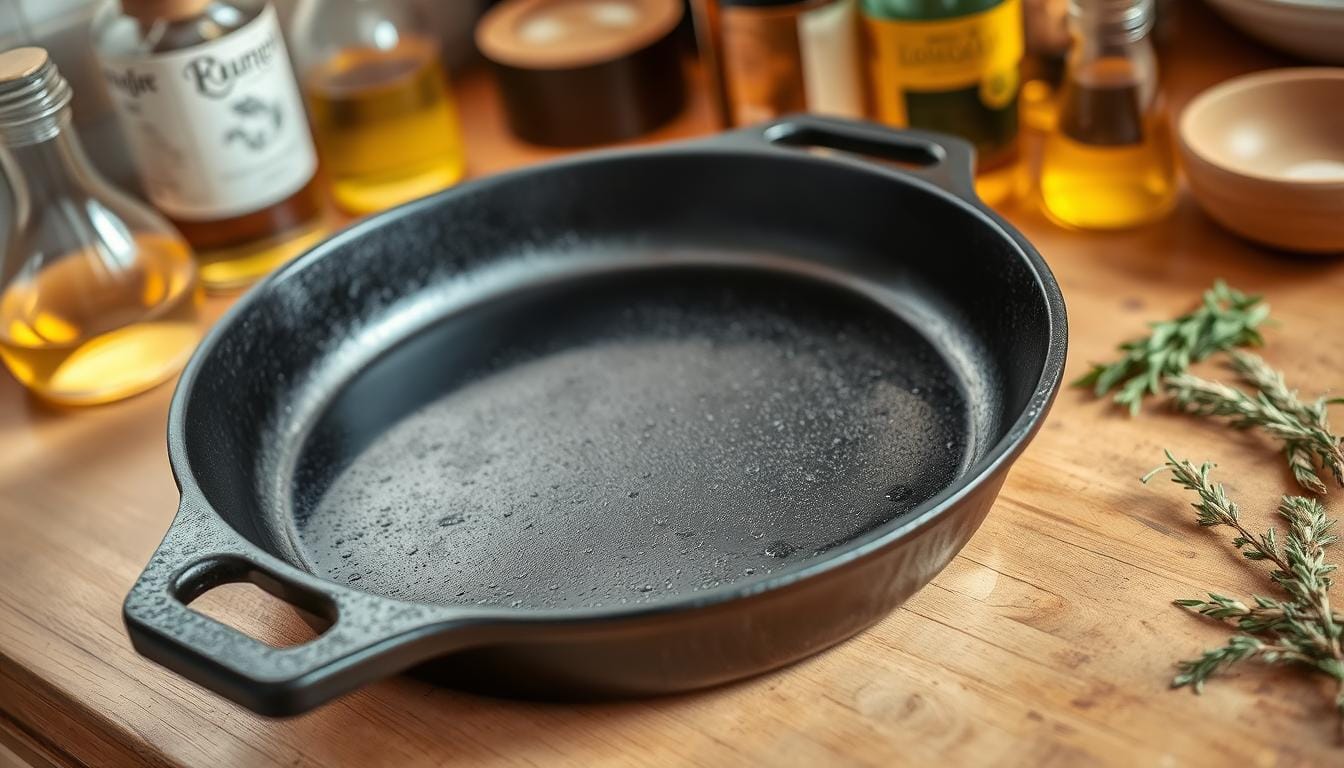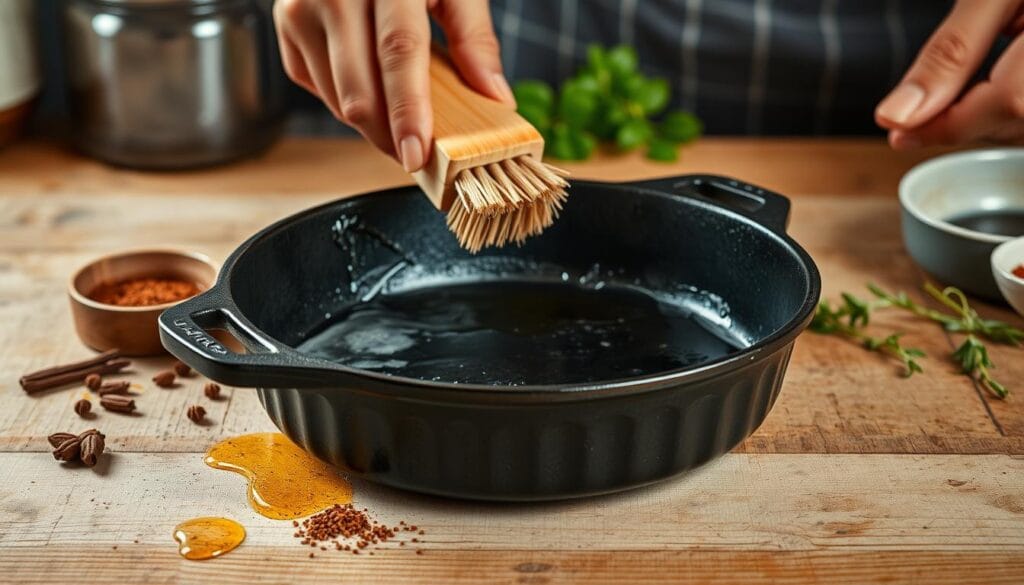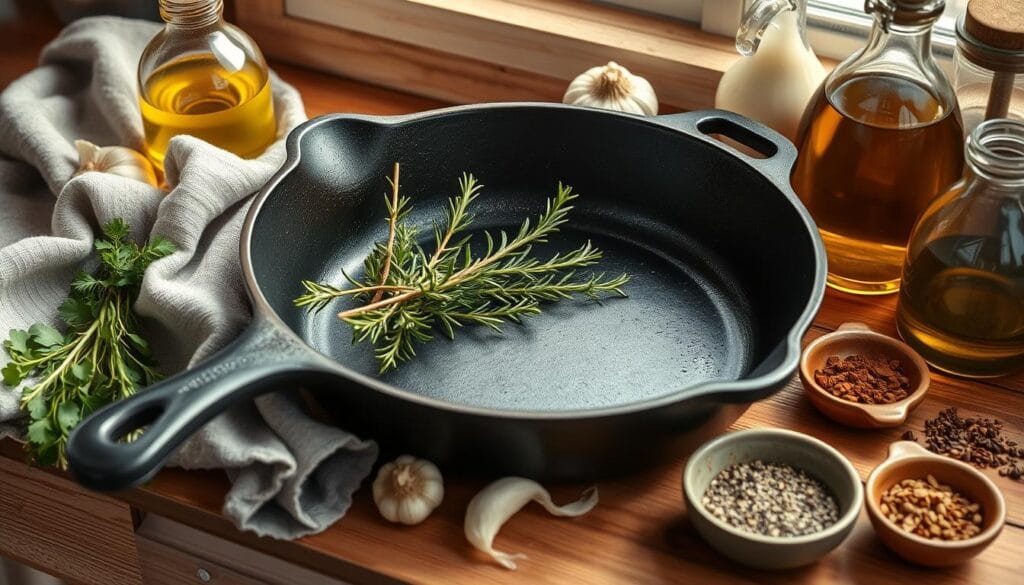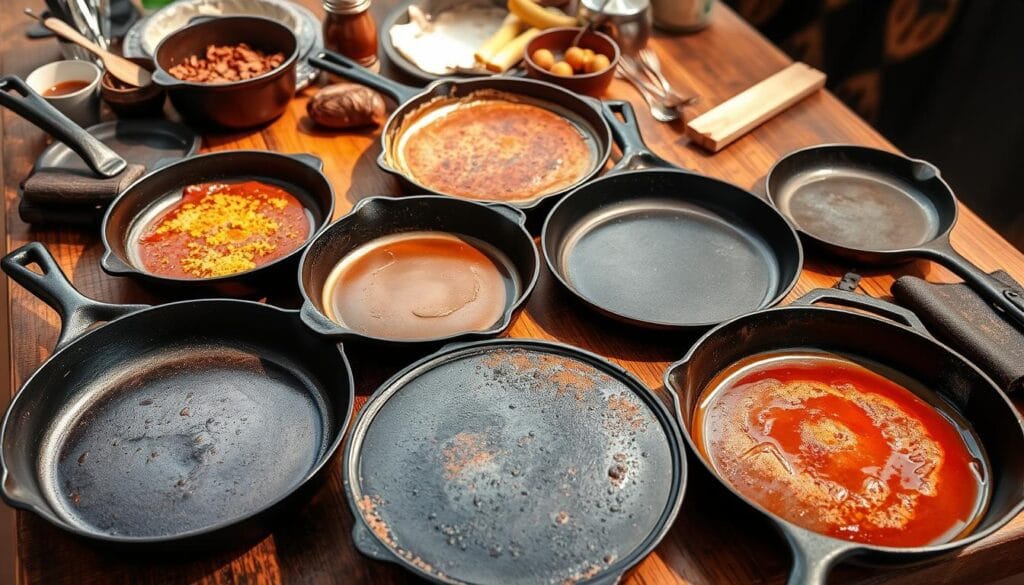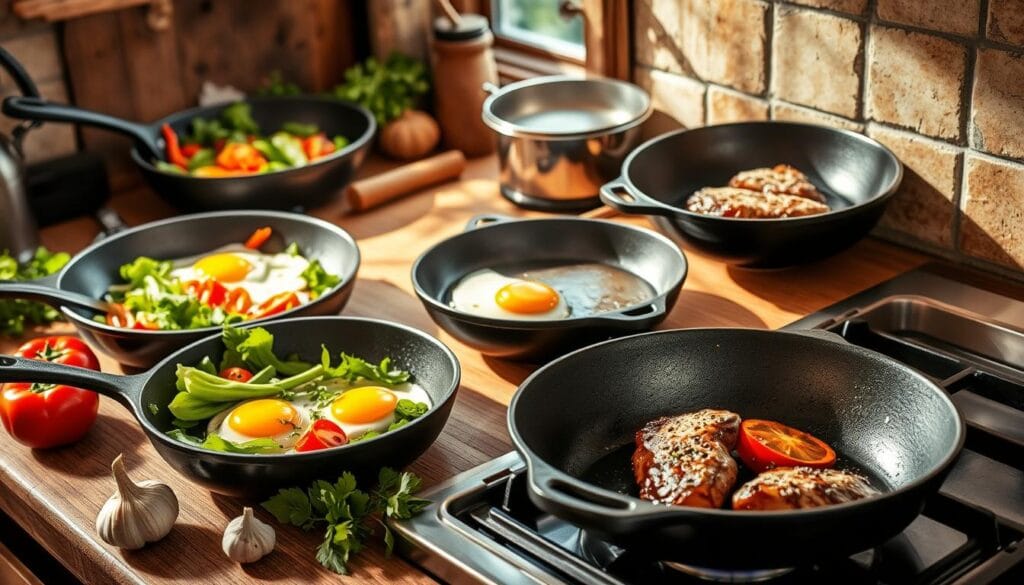Standing in my kitchen, the weathered cast iron pan caught my eye. It had been with me for years, through countless meals and memories. At first, it was dull and lifeless. But seasoning changed it, making it smooth and nonstick.
Seasoning a cast iron pan might seem hard, but it’s rewarding. It makes your pan a kitchen workhorse. By seasoning, you’ll connect more with your cookware. Let’s explore how to season your cast iron pan perfectly.
What Is Seasoning a Cast Iron Pan?
Seasoning makes your cast iron pan non-stick and durable. It involves applying a thin layer of oil and baking it at high heat. This turns the pan’s surface into a smooth, black finish that prevents rust and sticking.
Definition of Seasoning
Seasoning your cast iron pan means creating a hard, protective layer. This layer is made when oil polymerizes, turning into a non-stick surface. It improves the pan’s cooking and lasts longer.
Importance of Seasoning
Seasoning your cast iron pan is key for several reasons:
- It stops the pan from rusting and keeps it in great shape.
- The non-stick layer makes food release and cleaning easier.
- With time, a seasoned pan gets a unique flavor that boosts your dishes.
- A well-seasoned pan can last decades with the right care, making it a valuable kitchen asset.
Keeping your cast iron pan seasoned is vital for cast iron pan care and seasoning techniques. It’s essential for any serious cook or home chef.
Benefits of Using a Seasoned Cast Iron Pan
A seasoned cast iron pan is a great addition to any kitchen. It has many benefits, like being non-stick and improving flavors. It also lasts longer, making it a durable and versatile tool for cooking.
Enhanced Non-Stick Properties
One big plus of a seasoned cast iron pan is its non-stick surface. The seasoning creates a durable coating that works like modern non-stick pans. This makes food easy to release and cleaning up a breeze, perfect for many cooking tasks.
Improved Flavor Profile
A seasoned cast iron pan also boosts the taste of your food. The seasoning layer absorbs flavors from past meals, adding a unique taste to your dishes. This is great for searing meats, sautéing veggies, and making tasty pan sauces.
Increased Lifespan
Seasoning a cast iron pan makes it last longer, making it a smart kitchen investment. The seasoning acts as a protective layer, preventing rust and corrosion. This keeps your cast iron pan reliable for cooking for many years.
Whether you’re cooking a steak, baking a cobbler, or sautéing veggies, a seasoned cast iron pan makes a difference. It enhances your cooking and gives you great results. Get a high-quality cast iron pan and enjoy its versatility and longevity.
The Best Oils for Seasoning
Choosing the right oil for seasoning your cast iron pan is key. Not all oils are good for this task. Let’s look at some top choices.
Coconut Oil
Coconut oil is great for seasoning cast iron. It has a high smoke point, around 400-450°F (204-232°C). This makes it form a strong, non-stick layer.
Flaxseed Oil
Flaxseed oil is also popular for seasoning. It polymerizes well. But, it has a low smoke point, about 225°F (107°C). So, you need to apply it several times at low heat.
Vegetable Oil
Vegetable, canola, and corn oils are good for seasoning. They have high smoke points, 400-450°F (204-232°C). Lodge recommends using these oils for seasoning their pans.
The oil you choose affects the seasoning’s quality. Flaxseed oil might look great but can flake off. Coconut oil and others create a more lasting seasoning.
What’s the best oil for seasoning your cast iron? It depends on your preferences and needs. Try different oils to find the perfect one for you.
Preparing Your Pan for Seasoning
Before seasoning your cast iron pan, make sure it’s ready. This means cleaning it well to get rid of any dirt or rust.
Cleaning the Pan
Start by washing the pan with warm, soapy water and a scouring pad or steel wool. This removes factory residue or old seasoning. Rinse it well and dry it completely. You can dry it on the stovetop or in a 200°F oven for 5-10 minutes.
Inspecting for Rust
Look closely for rust on the pan. If you see rust, use steel wool to gently remove it. Be careful not to scratch the pan. After removing rust, dry the pan again before seasoning.
Properly preparing your cast iron pan is key for effective seasoning. Cleaning and checking for rust sets the stage for a great cooking surface.
“Seasoning your cast iron pan is like building a protective shield for your cookware. It’s an essential step that ensures your pan will perform at its best for years to come.”
Steps to Season Your Cast Iron Pan
Seasoning your cast iron pan is key to its great cooking and long life. By following these easy steps, you’ll get a non-stick surface that gets better with each use. Let’s explore how to season a cast iron pan.
Preheating the Oven
Start by heating your oven to 450-500°F (230-260°C). This high heat is crucial for seasoning. It helps the oil form a protective layer on the pan’s surface.
Applying Oil Evenly
After heating, spread a thin, even layer of oil over the pan. Use vegetable oil, melted shortening, or canola oil. These oils have high smoke points and are affordable. Use a clean cloth or paper towel to buff the oil and avoid pools.
Baking the Pan
With the oil spread out, put the pan upside down in the oven. Place a baking sheet under it to catch drips. Bake for about an hour, then turn off the oven and let it cool. Do this 3-4 times to build a strong seasoning layer.
Seasoning your cast iron pan right is vital for its non-stick and shiny surface. By following these steps, you’ll enjoy your well-seasoned cast iron pan for many years.
Tips for Creating a Strong Seasoning Layer
Getting your cast iron pan well-seasoned is key to its best performance. To create a strong seasoning layer, here are some expert tips:
Layering Technique
Instead of one thick layer, use a layering technique. Apply thin coats of seasoning oil, letting each layer cool and harden before adding the next. This method helps the seasoning stick well to the pan, avoiding stickiness or flaking later.
Temperature Control
The seasoning temperature is crucial. For oils like vegetable oil or canola oil, heat your oven to about 375°F (190°C). But for oils like sunflower oil, you might need to heat it to 475°F (246°C) for a strong seasoning.
Make sure each seasoning layer cools fully before adding the next. This careful process ensures a strong, lasting non-stick surface on your cast iron skillet.
“Layers of seasoning may flake off cast iron pans if not fully bonded to the metal.”
By using these cast iron seasoning tips, you’ll get a durable seasoning. This will make your seasoned cast iron skillet perform better and last longer.
Maintaining Your Seasoned Cast Iron Pan
Proper care and maintenance are key to keeping your cast iron pan in great shape. By following a few simple steps, you can make sure your pan cooks well for years. It will keep giving you great results.
Regular Cleaning Methods
After each use, clean your cast iron P with hot water and a soft brush or sponge. Don’t use harsh detergents or abrasive materials, as they can remove the seasoning. For stuck-on food, try using coarse salt to gently scrub the surface.
Once the pan is clean, dry it well and apply a thin layer of oil. This helps keep the seasoning intact.
Avoiding Abrasive Materials
Stay away from steel wool, scouring pads, or other abrasive materials when cleaning your cast iron P. These can damage the seasoning and make the surface rough. Instead, use soft, non-scratch sponges or brushes to gently remove food residue.
While you should avoid soap for regular cleaning, a small amount of mild dish soap can be used occasionally. This is if you need to remove stubborn grime. But make sure to rinse and dry the pan well afterward. This prevents soap residue from harming the seasoning.
Proper maintenance of your seasoned cast iron-pan ensures it cooks well for years. By following these simple care tips, you can enjoy your cast iron cookware. It will give you a cast iron maintenance and cast iron-pan care advantage.
Troubleshooting Common Issues
Keeping your cast iron-pan in good shape can be a challenge. But, with the right tips, you can easily fix common problems. Let’s look at some common issues and how to solve them.
Sticky Residue
Sticky residue on your cast iron-pan usually comes from too much oil. To fix it, clean the pan well to remove any extra oil. Then, apply a thin layer of oil and bake it in a hot oven for about an hour.
Flaking or Peeling Seasoning
If your seasoning is flaking or peeling, it might not be fully bonded. First, scrub the pan with a stiff brush, rinse it, and dry it completely. Then, re-season it properly to get a strong finish.
If problems keep happening, you might need to strip the pan and start over. This is a big job, but it’s sometimes needed to restore your pan to its best state.
| Common Cast Iron Problems | Troubleshooting Solutions |
|---|---|
| Sticky Residue | Clean thoroughly and re-season with a thinner layer of oil |
| Flaking or Peeling Seasoning | Scrub the pan, rinse, dry, and re-season; if persistent, strip and start over |
| Discoloration or Uneven Seasoning | Heat the pan over medium heat to remove excess oil; wipe with a paper towel |
| Rust Formation | Scrub under cold water, dry completely, and re-season to prevent further rusting |
Cast iron-pans need a bit of extra care, but it’s worth it. With some troubleshooting, you can keep your cast iron in great condition for many years.
When to Reseason Your Cast Iron Pan
Keeping your cast iron-pan in good shape is key. But how do you know when it needs a new seasoning? Look for signs like food sticking, the pan looking dull, or a rusty color. These can happen after cooking acidic foods like tomatoes.
Signs It’s Time to Reseason
- Food is sticking to the surface
- The pan looks dull or has developed a rusty appearance
- You’ve cooked acidic foods like tomatoes in the pan
Frequency of Reseasoning
How often you need to reseason depends on use. Generally, reseason your cast iron 1 to 2 times a year. But, if you cook often, you might only need to do it a few times a year.
Uneven seasoning or losing non-stick properties means it’s time. Regular oil use can help keep the seasoning up. This way, your cast iron will last longer and cook better.
“When seasoning a new pan, consider cooking fat-heavy preparations like frying chicken or bacon to enhance the seasoning process.”
A well-maintained cast iron P is a joy to use. It cooks better, tastes better, and lasts longer. So, take the time to reseason when needed. Enjoy cooking with your trusted cast iron P.
Cooking with a Seasoned Cast Iron Pan
Cast iron cookware is famous for its great heat retention and versatility. A seasoned cast iron P opens up a world of cooking possibilities. It lets you try different cooking techniques and make tasty cast iron recipes.
Suitable Cooking Techniques
Cast iron is great for high-heat cooking like searing, frying, and baking. It heats evenly and keeps the temperature steady. This makes it perfect for cooking steaks, frying chicken, and baking cornbread or skillet pizzas.
As your cast iron P gets more seasoned, you can cook more delicate foods. This includes eggs and fish.
Best Foods to Cook
- Steaks and chops
- Fried chicken and other fried foods
- Cornbread and other baked goods
- Skillet pizzas and flatbreads
- Eggs and delicate fish (with an established seasoning)
When using a new cast iron P, avoid cooking acidic foods for a long time. They can damage the seasoning. But as the seasoning gets thicker, you can cook a wider variety of dishes.
Always preheat your cast iron P slowly. This ensures even heat for the best cooking results.
“Cast iron cookware is a game-changer in the kitchen, unlocking a world of culinary possibilities with its exceptional heat retention and versatility.”
| Cooking Technique | Suitable Cast Iron Recipes |
|---|---|
| Searing | Steaks, chops, burgers |
| Frying | Fried chicken, fritters, doughnuts |
| Baking | Cornbread, skillet cakes, pizza |
| Roasting | Whole chicken, root vegetables |
| Braising | Pot roasts, stews, braises |
Storing Your Cast Iron Pan Properly
Proper storage is key to keeping your seasoned cast iron P in great shape. It helps prevent rust and keeps the seasoning layer intact.
Storage Tips
- Keep your cast iron in a dry, well-ventilated spot to avoid moisture.
- When stacking pans, use a paper towel or cloth between them to prevent scratches.
- For long storage, apply a thin layer of cast iron storage or vegetable oil. This protects against rust prevention.
Preventing Rust
Rust is a big enemy of cast iron. To avoid it, don’t store your pan with the lid on. This can trap moisture and cause rust. Also, stay away from damp or humid places, as they’re perfect for rust to grow.
| Proper Storage | Improper Storage |
|---|---|
| Dry, well-ventilated place | Damp or humid environment |
| Lightly oiled surface | Lid left on |
| Paper towel between stacked pans | Pans stacked without protection |
By sticking to these cast iron storage tips, your seasoned pan will stay in excellent condition. It’ll be ready to cook up tasty meals for many years.
Conclusion: Enjoying Your Cast Iron Pan
A cast iron pan is a valuable kitchen tool when seasoned and cared for right. It keeps heat well, has a natural non-stick surface, and makes food taste better. Using it often makes it even better over time.
It’s great for cooking everything from seared steaks to golden cornbread. A well-seasoned cast iron P offers unique cooking experiences. It’s something you can pass down to future generations.
Making It Last
A cast iron P can last for decades or even centuries with the right care. By following the seasoning and maintenance tips in this guide, your pan will stay reliable and durable. A quality cast iron piece, like the Lodge 10-inch skillet, can become a family heirloom.
Cooking Experiences with Your Pan
Cooking with a seasoned cast iron P can make your meals better. It cooks evenly and has a natural non-stick surface. This makes it perfect for searing meats, baking biscuits, and caramelizing veggies.
The pan’s heat retention is also great for slow-cooked dishes, braising, and baking. Using cast iron opens up a world of tasty meals to share with loved ones.
FAQ
What is the purpose of seasoning a cast iron pan?
Seasoning makes a hard, protective layer on cast iron. It turns the metal into a black, non-stick surface. This process prevents rust and makes the pan last longer.
What are the benefits of using a well-seasoned cast iron pan?
A seasoned pan is as non-stick as modern cookware. It adds flavor to food and lasts for generations. With care, it becomes a valuable kitchen tool.
What type of oil is best for seasoning cast iron?
Use unsaturated oils like vegetable, canola, or corn oil. Lodge recommends these for seasoning. Flaxseed oil might not work well. Choose oils with high smoke points for better results.
How do I prepare my cast iron pan for seasoning?
Clean the pan with warm, soapy water and dry it well. For new pans, this removes factory residue. For older pans, check for rust and remove it with steel wool. Heat the pan briefly to dry it before seasoning.
What are the steps to season a cast iron pan?
Heat your oven to 450-500°F (230-260°C). Spread a thin layer of oil on the pan, including the handle. Use a cloth to buff the oil evenly. Place the pan upside down in the oven on a baking sheet. Bake for an hour, then cool. Repeat this 3-4 times for the best seasoning.
How do I maintain the seasoning on my cast iron pan?
Clean the pan with hot water and a soft brush after each use. Don’t use soap to avoid stripping the seasoning. For stuck food, use coarse salt. Dry and oil the pan after cleaning. Avoid acidic foods until the seasoning is strong.
When should I re-season my cast iron pan?
Re-season when food sticks, the pan looks dull or rusty, or after acidic foods. Seasoning a few times a year helps. Regular oil use keeps the seasoning good. If the pan loses its non-stick, it’s time to reseason.

